Table of Contents
But what do we do, exactly? Ah yes, the age-old question we as marketers try to answer any time someone asks what we do for a living.
At HubSpot, we’re essentially a bunch of marketers who market marketing software to other marketers. It’s a little bigger than that, but you get it.
What size should my marketing team be?
The size of your marketing team will depend on the size of your business.
When I worked for a small consulting firm of about 100 people, our marketing team consisted of about eight of us.
Now that I work at HubSpot with 7,000+ employees, you can probably imagine the proportion of marketers we have spread across functions.
As a general reference point:
- Less than 25 employees = one kick-ass marketer
- 25 to 49 employees = about three marketers
- 50–249 employees = about eight marketers
- 250+ employees = about 30 to 100+ marketers
But your marketing team size will also be informed by your goals and your budget.
If I had a cupcake business (big sweet treat fan over here) and I wanted to increase leads from TikTok, I’d focus on hiring more social media specialists.
And as a consumer packaged goods company, I’d aim to spend about 25% of my revenue on marketing based on the average marketing budgets by industry.
Then, I’d have to break that down further to determine where hiring fits into my overall marketing spend.
The bottom line: I’ll always argue quality over quantity. The quantity will come as you scale, but you’ll need to establish a high-quality structure from the start to support it.
How to Structure a Marketing Department
So, I can’t tell you exactly how to structure your marketing department. There are way too many factors to consider.
But what I can do is outline three of the most common types of structures: by function, by discipline, and by product.
1. Marketing Department Structure by Function
Best for: SMBs (5 to 100 employees) with a marketing “team” of one who wears many hats and small teams that have limited headcount, resources, budget, and bandwidth.
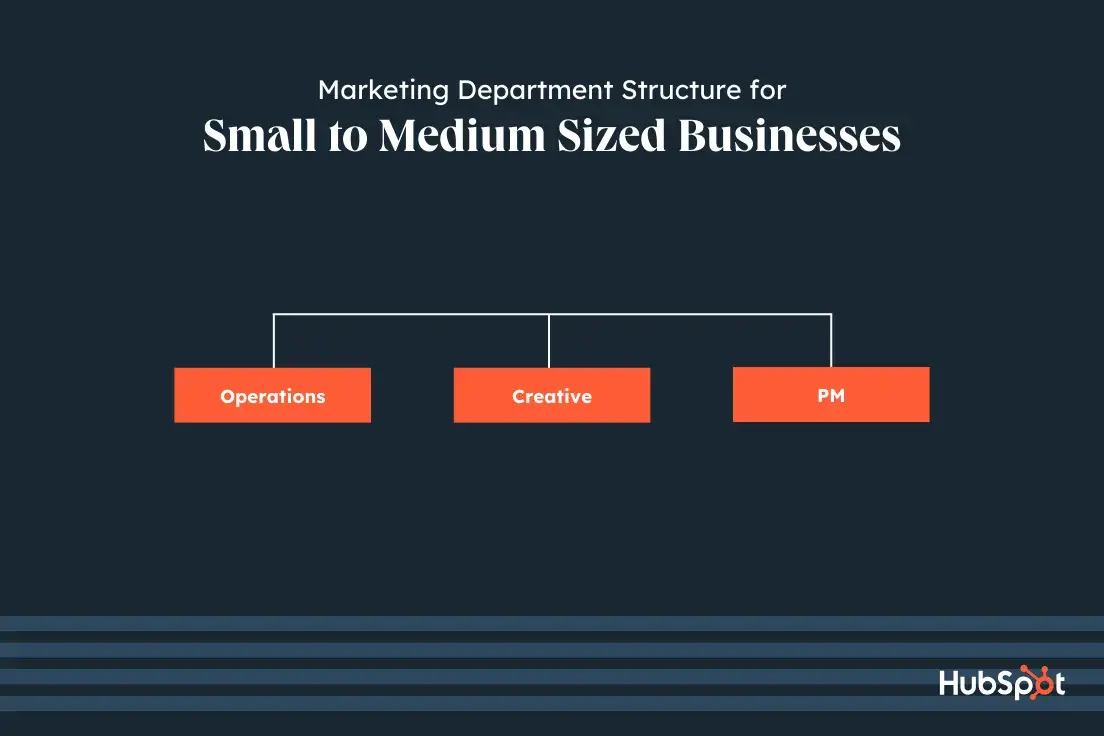
The functional department structure is similar to that of a bare-bones agency and includes the pillars of taking a campaign from ideation to completion.
A team like this may be made up of a few full-time folks, part-time people, or it could be staffed completely by contractors.
Common teams within marketing departments that are structured by function include:
- Operations
- Creative
- Project management
2. Marketing Department Structure by Discipline
Best for: Midsized companies (100 to 1,000 employees) where marketing owns a revenue number and is responsible for driving leads and contributing to the pipeline of the business.
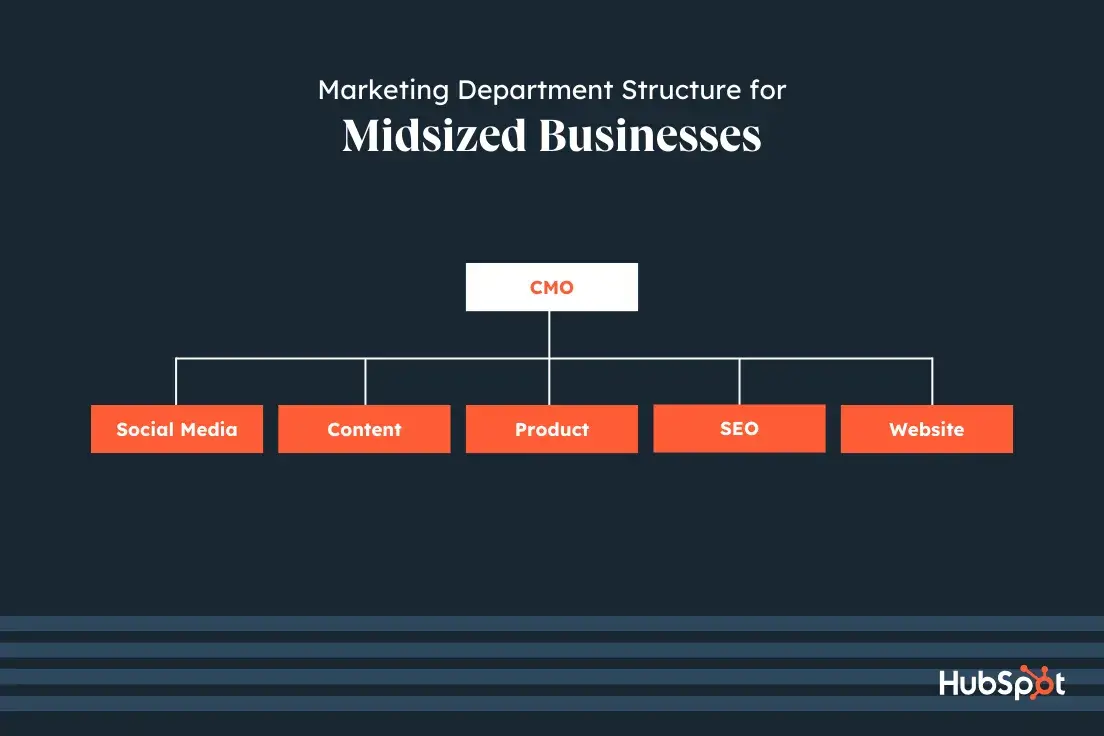
Marketing departments that are structured by discipline are the most common.
These teams will collaborate to execute campaigns frequently throughout the year in order to hit the company's revenue goals.
Common teams within marketing departments that are structured by discipline include:
- Social media
- Content marketing
- Product
- Search engine optimization (SEO)
- Website
3. Marketing Department Structure by Product
Best for: Enterprise businesses (1,000+ employees) with predictable revenue patterns that don't need to run frequent, stand-alone marketing campaigns to generate business.
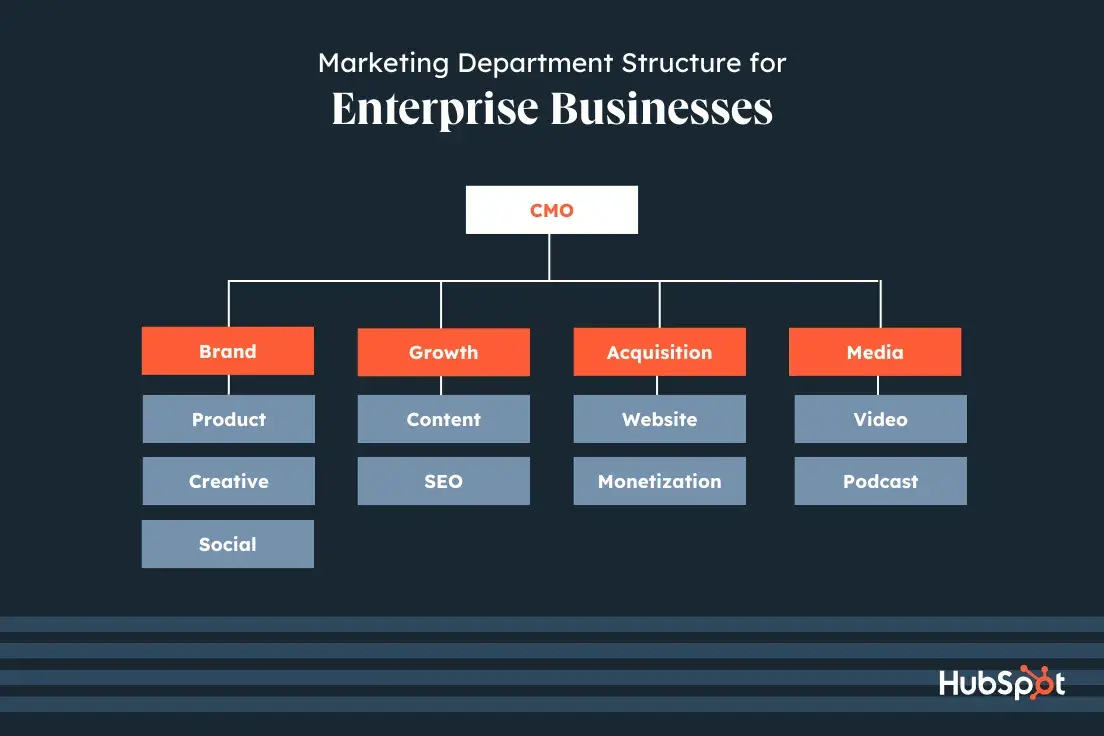
This marketing department structure organizes marketing teams by product.
If you have a proven marketing system in place to generate demand for the business, you can leverage a product-style marketing structure to grow in new, innovative ways.
Global teams may also appreciate this structure because it reduces role redundancy across regions and gives hiring managers an opportunity to recruit talent globally.
Common teams within marketing departments that are structured by product include:
- Brand
- Growth
- Acquisition
- Media
Types of Marketing Teams
I mentioned the marketing department structure by discipline is the most common structure, so I’ll break down some of the most common teams in that category.
Social Media
Your social media team will create and execute social media marketing efforts.
This team will need to have knowledge of how to make engaging content to drive brand awareness, generate leads, and connect with audiences.
Potential roles: Head Account Manager, Social Media Specialist, Content Creator, Social Media Analyst
Skills needed: Content creation, graphic design, social media management, project management, data analytics, and storytelling
General responsibilities:
- Create, schedule, and measure the performance of social content
- Develop social media images and videos using tools like Canva or Adobe
- Using social media management tools to track success
- Responding to customers who engage through social media tags or posts.
Making the most of your social media team structure:
- SMBs: Your dedicated marketing team member should have a general comfortability with basic marketing practices and social media experience to build an online presence.
- Midsized businesses: If you can afford multiple marketing roles, start specializing in marketing functions like social media manager, which can be its own role.
- Enterprise businesses: Consider structuring your social media team by having specialists and managers to lead and oversee social media strategy, as well as roles for day-to-day social media activities.
Pro tip: To help small teams, social media management software provides marketers with the tools they need to execute an entire social media strategy, such as the tools within HubSpot's Marketing Hub.
Content Marketing
Your content creators (read: me) will be the ones making sure your brand has enough content to tell a cohesive, compelling story. The content they produce will be useful in every facet of your marketing functions, from video to blog posts.
Potential roles: Head of Content, Video Producer, Staff Writer, Content Creator, Jr. Content Creator
Skills needed: Writing, editing, organization, graphic design, project management, SEO, HTML, and storytelling
General responsibilities:
- Create and edit content like blog posts, social media, and ebooks
- Product high-quality multimedia assets like podcasts, videos, and webinars
- Collaborate with creative teams and ensure messaging consistency across materials
Making the most of your content team structure:
- SMBs: Your content creation team might also be your social media and product team, so make sure they have good organization and time-management skills in a fast-paced environment.
- Midsized businesses: Take the time to hire a content creator who understands the story of your brand and brand voice.
- Enterprise businesses: Larger companies hiring for a content creation team can hire by skill or by the needs of other teams. For example, social media agencies need content creators for every client or group of clients.
Product
The product team communicates the features and benefits of your product to the customer. They'll organize and drive the messages of a product and how it connects to your brand and your target audience.
Potential roles: Brand Specialist, Product Marketing Specialist
Skills needed: Research, analysis, strategic planning, cross-functionality, writing, customer service, a creative problem-solving mindset, technical knowledge, pricing strategy, and solving for the customer
General responsibilities:
- Identify target audiences to communicate with through product pages and ad copy
- Plan campaigns for new and existing products or services
- Build product pages and strategize product promotion
- Research, analyze metrics, use that knowledge to plan future campaigns
- Demonstrate a deep understanding of overall marketing functions
Making the most of your product team structure:
- SMBs: The product marketer you hire as a small business owner is likely your only marketer, so hire someone with a background or demonstrated knowledge in writing, presenting marketing, and business.
- Midsized and enterprise businesses: Consider hiring product marketers by product stack (e.g., phones for a tech company) or by speciality (e.g., a role based solely on developing copy or producing strategy).
Search Engine Optimization
The SEO team will mainly be driving traffic to your webpages by optimizing content and ensuring your brand is ranking on the SERPs for topics related to your product or service.
To accomplish these goals, you need people with strong technical, programming, and writing skills.
Potential roles: SEO Strategist, Senior SEO Strategist, Historical Optimization Writer
Skills needed: Writing, editing, problem-solving, experience with programming and technical thinking, analytics, spreadsheets, drive, and the ability to adapt
General responsibilities:
- Write, edit, and proofread content
- Optimize content for search engines and key audiences
- Conduct keyword research and identity ranking opportunities
- Analyze content performance to inform future keyword strategies
Making the most of your SEO team structure:
- SMBs: Make sure your SEO functions are being carried out by someone who has an understanding of analytics, optimizing content for search engines, and keyword research.
- Midsized businesses: Consider hiring for different specialties within SEO like historical optimization, link-building management, and raising webpage traffic.
- Enterprise businesses: Consider hiring managers who are SEO experts that can offer seasoned advice to other team members and manage multiple SEO projects at once.
Website
Of course, any business needs a website. And as your company grows, you may find the need to hire someone full-time to maintain your website.
This team will be responsible for all things dot com, so you should hire a creative proficient in web design, web strategy, and optimization.
Potential roles: Web Developer, Senior Web Developer, UX/UI Designer, Front-end Web Developer, Web Designer, Visual UX Developer, Graphic Design Specialist
Skills needed: Programming, Creative Suite programs, interpersonal communication, website and email design, UX orientation, content management software, understanding of web standards and best practices, and SEO
General responsibilities:
- Demonstrate a mastery of programming and web design
- Develop new web pages and refresh existing content
- Build new web experiences and refine customer touchpoints
- Improve user experience across the website
- Serve as the point of contact for web-related issues
Making the most of your website team structure:
- Businesses of all sizes: I’d recommend structuring your web design by need. If you can afford to build out an entire team, you can start hiring Senior Web Developers to bring your site up to current standards and maintain it.
Other Types of Marketing Teams
Here’s a quick and dirty rundown of the other types of teams I called out in the function and product structure categories.
Operations
Your operations team is responsible for managing the technical aspects of your marketing efforts. They'll maintain the tech stack, handle marketing automation, manage email marketing workflows, and schedule and produce webinars.
Skills needed: Workflows, automation, written and verbal communication skills, problem-solving, team-building
Creative
The creative team is in charge of what your clients or customers see when they come across your brand. This team will take on graphic design, copywriting, video production, and some web design.
Skills needed: Graphic design, written communication, video production, photography, copywriting, front-end web design
Project Management
To keep everything on schedule, within budget, and within scope, the project management team will step in. The individuals in this role will typically coordinate with both operations and creative in order to keep things moving.
Skills needed: Organization, project management, agile framework, budgeting, time management, written and verbal communication
Brand
Your brand team knows everything about your business and distills it in such a way that potential, new, and existing customers can relate to it and external entities can appreciate it.
Skills needed: Strategic thinking, written and verbal communication, creativity, copywriting, social media management, customer journey mapping, and buyer journey mapping
Growth
Your growth marketing team is responsible for generating demand and leads for the business either in existing or new markets.
Skills needed: Content marketing, content strategy, SEO, copywriting, web design, UI/UX design, and HTML
Acquisition
Your acquisition team will be made up of people who live and breathe methods for delighting the customer through every step of their buyer‘s journey. You’ll look to your acquisition-ers to secure leads and fill the pipeline for sales.
Skills needed: Conversion rate optimization, UI / UX design, HTML, content development, content design, and data analysis
Media
Your media team should encompass many of the functions listed above, but it does so with an emphasis on the audience experience. Your media team understands that media products are best built when your brand has a strong foothold in the market.
Skills needed: Video production, video editing, public speaking, creative writing, research, data analysis, and journalism
Common Marketing Team Roles
Any successful marketing department structure needs a leadership and individual contributor hierarchy.
How deep or wide you choose to organize your team is up to you, but here are the primary roles you can expect to see in any marketing team.
Marketing People Leader Roles
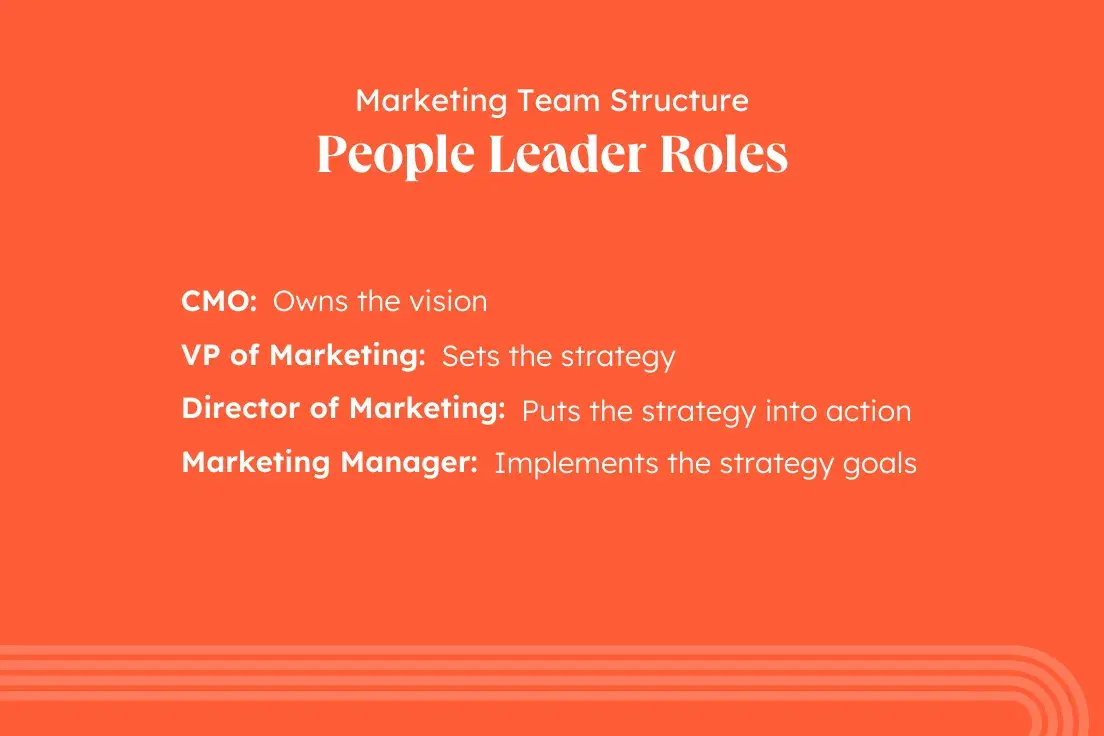
- Chief Marketing Officer (CMO): Decision maker, owns the vision and champions the team culture. Reports to the CEO.
- Vice President (VP) of Marketing: Sets the strategy for the marketing department at a high level. Reports to the CMO.
- Director of Marketing: Sometimes referred to as the “Head” of Marketing. Puts the strategy from the VP into an actionable plan that managers can rally their teams around.
- Marketing Manager: People leaders on the front lines who manage individual contributors and are responsible for guiding their team toward meeting the goals of the larger strategy.
Marketing Individual Contributor Roles
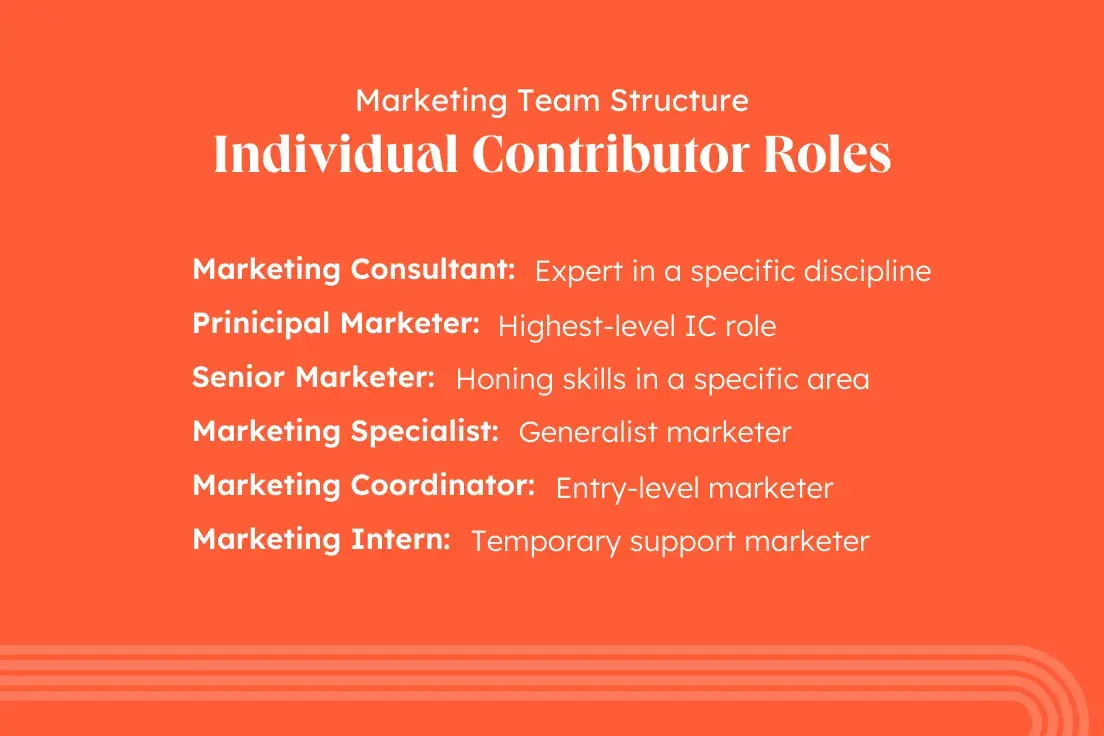
- Marketing Consultant: Typically an expert in a specific discipline like SEO or content creation. They are hired as a freelancer, contractor, or even on a part-time basis to help marketing teams reach their goals.
- Principal Marketer: Highest-level full-time roles an individual contributor can attain in their career. Masters of their discipline rather than a jack of all trades.
- Senior Marketer: Actively honing their skills in a specific discipline, but may take on projects with a wider scope to build other soft and hard skills.
- Marketing Specialist: Plays more of a generalist role on the team. Encouraged to explore marketing disciplines to gain an understanding of how tactics work together to achieve the strategy.
- Marketing Coordinator or Associate: Entry level position for recent graduates or new marketing professionals who want to change careers. They'll take on ad-hoc assignments in various marketing departments and begin to build relationships with more senior team members.
- Marketing Intern: Temporary employee that is completing a degree of some kind, usually in an area of marketing or communications. May be offered a full-time position as a marketing associate or coordinator upon graduation.
How to Build a Marketing Team
Now that we’ve covered marketing team sizes, department structures, and common roles, it’s time to dive into what you’ve all been waiting for … the how.
1. Create a hiring strategy.
Start here: Before you can hire anyone, you need to put a strategy in place for building your marketing team. To do this, you‘ll need a clear understanding of your organization’s hierarchy.
You’ll also need to consider the needs of the business.
Are there specific areas where you need additional support? Maybe you have a social media specialist that’s great at the day-to-day, but you need someone at the manager level to really drive your strategy.
Are there any gaps in your marketing department? If you’re focused on bringing in leads but don’t have a dedicated acquisition expert, this is your opportunity to bring one on.
More often than not, hiring without a strategy leads to redundancy and role confusion.
2. Write the job descriptions.
Once you nail down your strategy, it’s time to write the job descriptions and begin recruiting.
Luckily, we have an entire post dedicated to job description best practices.
However, I believe the most important way to write a good job description is to make sure you have a clear understanding of your target candidate.
I’ve written several marketing job descriptions in the past, and this understanding always mapped back to the needs our team identified in step one.
Once you know who you’re looking to hire, this will make it easier to create a job description that’s concise, realistic, and free of any bias.
3. Source candidates.
Before you begin recruiting candidates from external sources, try looking for interest internally first.
Internal candidates give you an opportunity to help an employee progress their career. Plus, it saves you time and resources that you'd otherwise spend looking for external talent.
If you've exhausted your internal talent pool or you need a more specialized skill set, there are several resources available to make this happen.
You can look to recruiters, headhunters, and candidate sources to help with the search. You can also browse candidate collectives or private membership groups like Black Marketers Association of America to list your job posting.
LinkedIn is also a great place for sourcing and vetting candidates. Why not work with your mutual connections to find your next great hire?
I’m sure you’ve seen the #OpenToWork and #Hiring photo frames by now. Read here to see if they actually work.
4. Extend an offer.
There's a lot of discourse about how to interview for top marketing talent. How many interviews are too many? How do you know which candidate is the right fit? How long should the process take?
We know that can be a challenge for small and large companies alike, so use this free resource to understand what you need to ask to evaluate your candidates objectively.
Once you're ready to extend an offer, consider all the variables: their experience, their interview performance, their formal marketing training (courses, degrees, certifications), and any special skills that will help round out your team.
Use this information to craft a fair offer that aligns what they bring to the table with what the market demands.
Be prepared for negotiations and questions about commonly overlooked benefits like insurance, on-call responsibilities, and professional development allowances.
5. Onboard your new hires.
After you‘ve done the hiring, you aren’t done building a great team. The work continues long after the offer letter is signed.
Create or refine your onboarding process so it helps your new employees understand the business, the team culture, and their role. Both parties (you and the new hire) should feel like they made the right decision by joining the company.
Plus, research shows that organizations with strong onboarding processes increase new hire retention by 82% and improve productivity by 70%. Win.
One Step Closer to Your Marketing Dream Team
Hiring the best talent will require knowing the best skills for each role. Even if you only have the capacity to hire for one or two marketing roles right now, it's a good idea to invest in people with the potential to grow into new roles in the future.
When you start with the right structure for your business type, put the right steps in place for hiring, and get the team aligned on a common vision, you'll have a marketing team that will make even the Fortune 100 companies jealous.
Editor's note: This post was originally published in November 2014 and has been updated for comprehensiveness.
Management
.png?width=112&height=112&name=Image%20Hackathon%20%E2%80%93%20Vertical%20(19).png)


.png)




![Why Every Company Needs an Operating Model [+ Steps to Build One]](https://53.fs1.hubspotusercontent-na1.net/hubfs/53/Operating%20Model.webp)

![5 Clues You Micromanage and How to Stop [Quiz]](https://53.fs1.hubspotusercontent-na1.net/hubfs/53/micromanage-definition.jpg)


